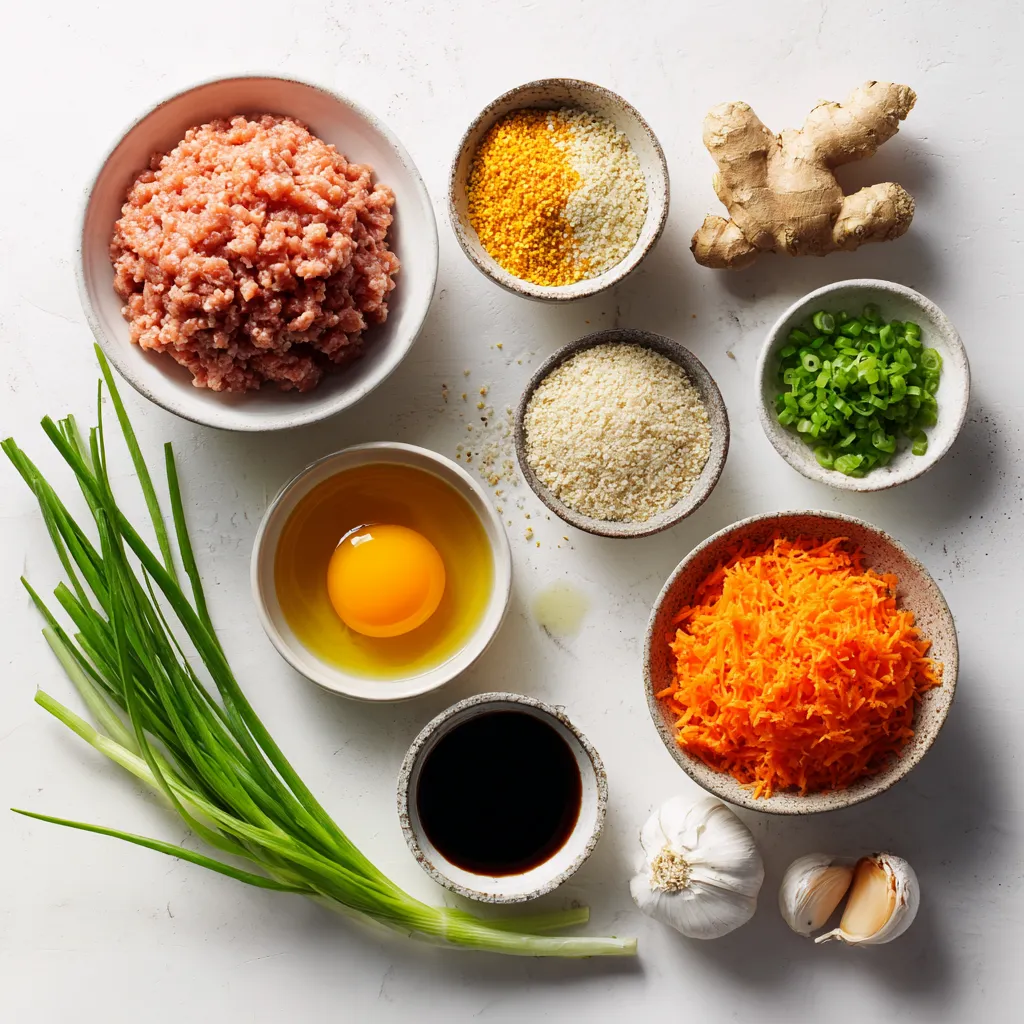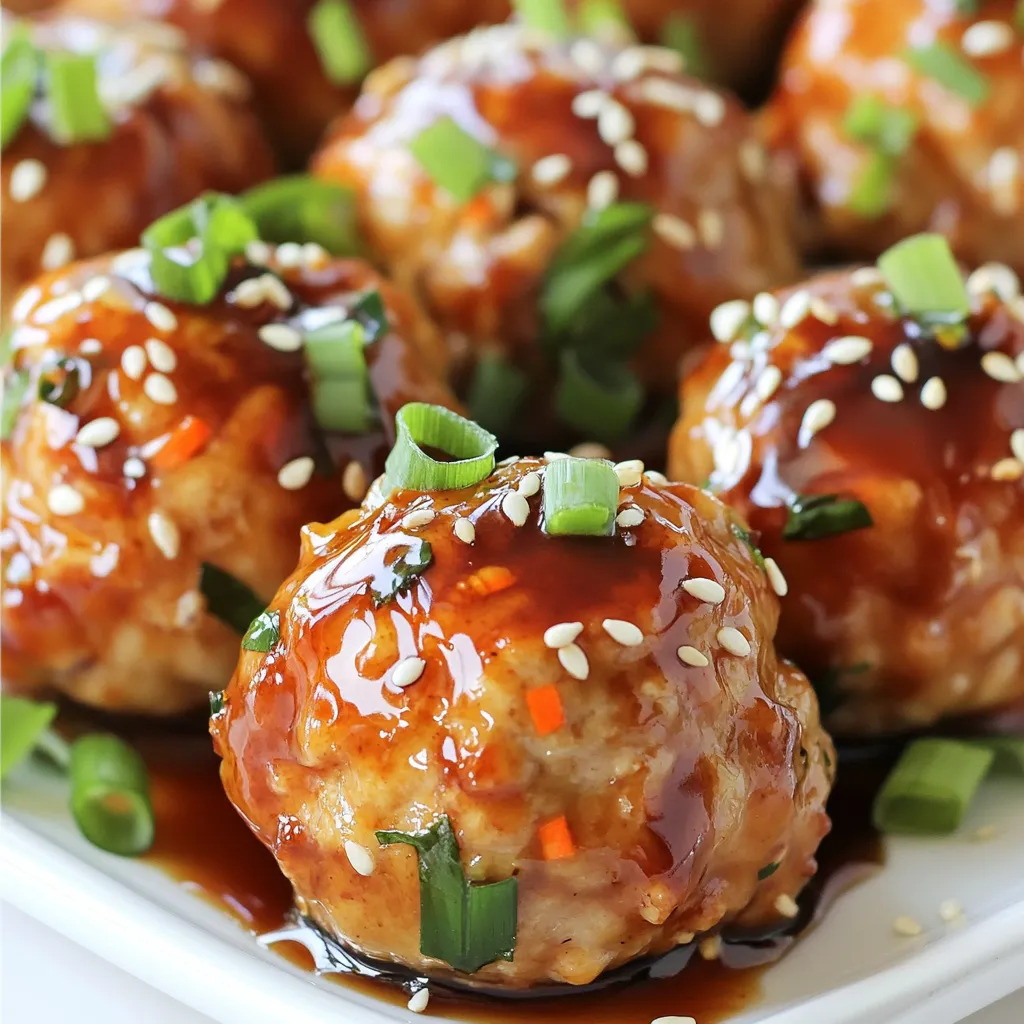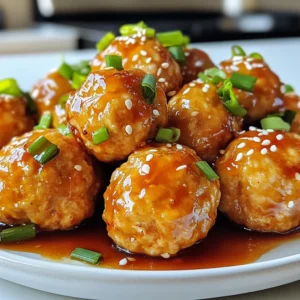Teriyaki Chicken Meatballs Flavorful and Simple Recipe

Looking for a tasty dish that’s easy to make? Try my Teriyaki Chicken Meatballs! This meal is packed with flavor and simple to prepare. You’ll impress your family and friends with this juicy dish. In this post, I’ll share my favorite recipe, tips for perfect meatballs, and even some fun variations. Let’s dive into this delicious journey together and make mealtime exciting!
Why I Love This Recipe
- Deliciously Flavorful: These teriyaki chicken meatballs are packed with flavors from ginger, garlic, and a sweet soy sauce glaze, making each bite irresistible.
- Easy to Make: This recipe is straightforward and requires minimal prep time, making it perfect for busy weeknights or quick meal prep.
- Healthy Ingredients: Using ground chicken and fresh vegetables means these meatballs are a healthier alternative to traditional meatballs, without sacrificing taste.
- Versatile Serving Options: These meatballs can be served as an appetizer, over rice, or in a wrap, providing flexibility for any meal occasion.
Ingredients
List of Ingredients Needed
To make teriyaki chicken meatballs, gather these items:
- 1 lb ground chicken
- 1/4 cup breadcrumbs
- 1/4 cup grated carrot
- 1/4 cup green onions, finely chopped
- 1 garlic clove, minced
- 1 tablespoon fresh ginger, minced
- 1 egg, lightly beaten
- 1/4 cup soy sauce
- 2 tablespoons honey
- 1 tablespoon rice vinegar
- 1 tablespoon sesame oil
- 1 teaspoon cornstarch mixed with 1 tablespoon water (slurry for sauce)
- Sesame seeds and additional chopped green onions for garnish
Optional Ingredients for Extra Flavor
You can add more flavor with these ingredients:
- Chopped red pepper flakes for spice
- Pineapple chunks for sweetness
- Chopped cilantro for freshness
Recommended Tools and Utensils
To prepare this dish, use the following tools:
- Mixing bowl
- Baking sheet
- Parchment paper
- Small saucepan
- Whisk for sauce
- Measuring cups and spoons
- Spoon or cookie scoop for forming meatballs

Step-by-Step Instructions
Mixing the Meatball Ingredients
To start, grab a big mixing bowl. Add the ground chicken, breadcrumbs, and grated carrot. Toss in chopped green onions, minced garlic, and minced ginger. Remember to add the lightly beaten egg. Use your hands or a fork to mix it all well. Make sure every bite has a nice blend of flavors.
Preparing the Oven and Baking Sheet
Now, let’s get the oven ready. Preheat it to 400°F (200°C). While it heats, line a baking sheet with parchment paper. This step helps keep the meatballs from sticking and makes cleaning easy.
Forming and Baking the Meatballs
Next, take about a tablespoon of the chicken mix. Roll it into a ball shape with your hands. Place each meatball on the baking sheet. Make sure they are about an inch apart. This space helps them cook evenly. Bake them in the oven for 15-20 minutes. Look for a nice golden brown color to know they’re done.
Making the Teriyaki Sauce
While the meatballs bake, let’s whip up the teriyaki sauce. In a small saucepan, combine soy sauce, honey, rice vinegar, and sesame oil. Heat it over medium heat. Stir it well and wait for it to simmer gently.
Thickening the Sauce
Once the sauce simmers, add the cornstarch slurry. Keep stirring for 1-2 minutes. This will help the sauce thicken nicely. When you reach the right consistency, remove it from the heat.
Coating and Garnishing the Meatballs
After the meatballs are golden, take them out of the oven. Carefully move them to a serving dish. Pour the warm teriyaki sauce over the meatballs. Make sure each meatball gets a nice coating. For a final touch, sprinkle sesame seeds and chopped green onions on top. This adds flavor and makes your dish look beautiful. Enjoy your tasty teriyaki chicken meatballs!
Tips & Tricks
Best Practices for Juicy Meatballs
To make the juiciest meatballs, I use ground chicken. It’s lean, yet tender. Add breadcrumbs to help bind the meat. The grated carrot also adds moisture and sweetness. Make sure not to overmix the meatball mixture. This keeps them soft. Roll them gently into balls. This helps them stay light and fluffy.
Flavor Enhancements and Additions
You can add more flavors easily. Try mixing in some chopped herbs like cilantro or basil for freshness. A splash of sriracha adds a nice kick if you like spice. You can also swap honey for maple syrup for a different sweetness. Want some crunch? Toss in finely chopped bell peppers.
Common Mistakes to Avoid
A few mistakes can ruin your meatballs. One common error is baking them at too high a temperature. Stick to 400°F for even cooking. Another mistake is using too much filler, like breadcrumbs. This can dry them out. Finally, don’t skip the sauce! The teriyaki glaze is key to making these meatballs shine.
Pro Tips
- Use Fresh Ingredients: Fresh ginger and garlic add a vibrant flavor to your meatballs. Whenever possible, use fresh rather than jarred or powdered options for the best taste.
- Don’t Overmix: While it’s important to combine the ingredients well, overmixing can result in tough meatballs. Mix just until everything is incorporated.
- Adjust Sauce Thickness: If you prefer a thinner sauce, reduce the amount of cornstarch in the slurry. Conversely, add more cornstarch for a thicker sauce to suit your preference.
- Experiment with Flavors: Feel free to add other ingredients like chopped bell peppers or cilantro to the meatball mixture for added flavor and texture. Make this recipe your own!

Variations
Spicy Teriyaki Chicken Meatballs
You can spice up your teriyaki chicken meatballs easily. Add some heat by mixing in sriracha or chili flakes. Start with a teaspoon of sriracha in the meatball mix. Taste and adjust to your heat level. You can also add a dash of hot sauce to the teriyaki sauce for an extra kick.
Teriyaki Chicken Meatballs with Veggies
For a healthy twist, add vegetables to your meatballs. You can mix in finely chopped bell peppers, zucchini, or mushrooms. Grated zucchini keeps the meatballs moist. Just make sure to squeeze out extra water from the veggies before mixing. This keeps the meatballs from being too soggy while baking.
Gluten-Free Adaptations
If you want gluten-free meatballs, swap out regular breadcrumbs for gluten-free ones. You can also use crushed gluten-free crackers or oats as a binder. Check your soy sauce for gluten-free options, like tamari. These swaps make the dish safe for those with gluten sensitivities, while keeping it delicious.
Storage Info
How to Store Leftover Meatballs
To keep your leftover meatballs fresh, follow these steps:
- Let the meatballs cool to room temperature.
- Place them in an airtight container.
- Store in the fridge for up to 3 days.
This method helps keep the meatballs moist and tasty.
Freezing Instructions for Meal Prep
Freezing is a great way to save time. Here’s how to do it:
- Allow cooked meatballs to cool completely.
- Arrange them in a single layer on a baking sheet.
- Freeze for about 1-2 hours until firm.
- Transfer the meatballs to a freezer-safe bag or container.
- Label with the date and freeze for up to 3 months.
This way, you can enjoy them later.
Reheating Tips for Optimal Flavor
Reheating meatballs can be simple and rewarding. Try these tips:
- For the oven, preheat to 350°F (175°C).
- Place meatballs on a baking sheet.
- Heat for about 15-20 minutes until warmed through.
- For microwave reheating, place meatballs in a bowl with a splash of water.
- Cover and heat for 1-2 minutes in short bursts.
These methods keep the meatballs juicy and help the flavors shine.
FAQs
How do I know when the meatballs are cooked?
You can tell the meatballs are cooked when they are golden brown. Use a meat thermometer to check if the inside reaches 165°F (75°C). This means they are safe to eat. If you cut one open, the center should not be pink.
Can I use other types of meat for this recipe?
Yes, you can use other meats. Ground turkey or pork works great too. Each type of meat adds a unique flavor. Just adjust the cooking time if needed.
What can I serve with teriyaki chicken meatballs?
These meatballs pair well with rice or noodles. You can add steamed veggies for a healthy touch. A simple salad also makes a great side.
How do I make teriyaki sauce from scratch?
To make teriyaki sauce, mix soy sauce, honey, rice vinegar, and sesame oil. Heat the mix in a saucepan. Stir in cornstarch slurry to thicken it. Cook until it reaches your desired thickness.
Can I make this recipe ahead of time?
Yes, you can prepare the meatballs ahead of time. Form them and store in the fridge for up to a day. You can also freeze them for later. Just cook them straight from frozen when ready.
This post covered everything you need for teriyaki chicken meatballs. We went through key ingredients, step-by-step cooking, and helpful tips. You learned how to adapt the recipe and store leftovers too.
Remember to try adding your favorite flavors and avoid the common mistakes. With practice, you’ll master these meatballs. Cooking can be fun and rewarding. Enjoy your dish and share it with family and friend






![- 8 oz linguine or spaghetti - 1 lb large shrimp, peeled and deveined - 4 cloves garlic, finely minced - 1/4 cup extra-virgin olive oil - 1 teaspoon red pepper flakes - 1/2 cup fresh parsley, finely chopped - 1 lemon, juiced and zested - Salt and freshly ground black pepper to taste - Grated Parmesan cheese (optional) To make Quick Garlic Shrimp Pasta, you need fresh and quality ingredients. The base of this dish is linguine or spaghetti, which holds the sauce nicely. I love using large shrimp because they cook quickly and have a great flavor. Garlic is a must here. It adds a rich, aromatic taste that makes the dish special. Next, the olive oil brings everything together. I always choose extra-virgin for its fresh and fruity flavor. Red pepper flakes add that perfect kick. Adjust the amount to fit your spice level. Fresh parsley brightens the dish, making it look vibrant. The lemon juice and zest add a zesty touch that balances the richness. Don’t forget salt and pepper to enhance all the flavors. If you want to make it extra savory, sprinkle some grated Parmesan cheese on top. These ingredients work together to create a dish that is simple yet full of flavor. For the full recipe, refer to the section above. - Bring a large pot of water to a boil. - Add salt to the water for flavor. - Cook the pasta according to the package instructions. - Reserve about 1 cup of the pasta water before draining. - Heat olive oil in a large skillet over medium heat. - Add minced garlic and red pepper flakes. - Sauté the garlic for about 30 seconds until fragrant. - Introduce the shrimp into the skillet. - Season the shrimp with salt and black pepper. - Cook for about 2-3 minutes until the shrimp turn pink and opaque. - Toss the cooked pasta into the skillet with the shrimp. - Add the reserved pasta water for creaminess. - Pour in lemon juice and zest for brightness. - Fold in the chopped fresh parsley for a fresh taste. - Taste and adjust seasoning if needed. - Plate the pasta into individual bowls. - Garnish with extra parsley and a lemon wedge. - Serve warm and enjoy this dish. For detailed cooking steps, check the Full Recipe. To get the best garlic taste, avoid burning it. When you heat garlic, it should become fragrant but not brown. Burnt garlic can taste bitter and ruin your dish. Start with medium heat and watch it closely. If you like spice, adjust the red pepper flakes. Add more for heat or less for mildness. Taste as you go, and find what suits you best. Cooking pasta to al dente is key. This means the pasta should be firm but not hard. Overcooked pasta can turn mushy and lose its bite. Before draining your pasta, save some pasta water. This starchy water helps the sauce stick and adds flavor. It’s a simple trick that makes a big difference! For side dishes, consider a fresh salad or garlic bread. These pair well with the pasta and add balance to your meal. When it comes to wine, a crisp white wine works best. Look for a Sauvignon Blanc or a Pinot Grigio. These wines enhance the garlic flavors and make the meal feel special. {{image_4}} You can switch up the pasta to fit your needs. Try whole wheat or gluten-free pasta. Both options work well with this dish and add a different taste. Fresh herbs can change the flavor too. Use basil or chives for a fresh twist. They brighten up the shrimp pasta and add a new layer of taste. You can explore other seafood options if you want. Scallops and calamari both taste great in this dish. They offer a nice change from shrimp while keeping the dish light. For a vegetarian version, use mushrooms instead of shrimp. Mushrooms have a meaty texture and soak up flavors well. This swap keeps the dish satisfying without meat. Want a richer sauce? Adding cream can make your dish more decadent. It gives the pasta a smooth texture that many love. You can also add cherry tomatoes for freshness. They pop with flavor and add color to your plate. This small change can elevate your garlic shrimp pasta experience. For a full recipe, check out the details above. To store leftover pasta, place it in an airtight container. Make sure to let it cool first. This helps prevent sogginess. You can keep it in the fridge for up to three days. After that, the shrimp may lose its quality. Always check for any off smells or changes in color before eating. When reheating pasta, use a skillet. This keeps the dish from getting too dry. Add a splash of water or olive oil to help. Heat it on low, stirring gently. Avoid using the microwave if you can. It can make the shrimp rubbery. Always taste a little before serving to ensure it's warm and flavorful. Yes, you can freeze garlic shrimp pasta! First, let the dish cool completely. Then, place it in a freezer-safe container. Leave some space for expansion. You can freeze it for up to two months. To thaw, move it to the fridge overnight. Reheat it on the stove, adding a bit of water or oil to restore moisture. You can make Quick Garlic Shrimp Pasta in about 30 minutes. - Prep time: 10 minutes - Cooking time: 20 minutes Yes, you can use frozen shrimp. Just thaw them first. - To thaw shrimp, place them in cold water for about 15-20 minutes. - Ensure shrimp are peeled and deveined before cooking. You can pair this dish with several sides: - A fresh garden salad - Garlic bread for dipping - Steamed vegetables like broccoli or asparagus To reduce the spice, you can: - Use fewer red pepper flakes or omit them. - Add more olive oil or butter to mellow the heat. I recommend using linguine or spaghetti. - These pasta types hold the sauce well. - You can also try fettuccine for a different texture. For the full recipe, refer to the [Full Recipe]. Quick Garlic Shrimp Pasta is simple and tasty. You learned about key ingredients, cooking steps, and useful tips. I focused on making garlic and shrimp shine while keeping it easy. You can swap out ingredients, store leftovers, and reheat without losing flavor. Try different flavors to make it your own. Follow these steps, and enjoy a delicious meal any day of the week. Cooking should be fun and satisfying, so gather your ingredients and start creating!](https://dishtreats.com/wp-content/uploads/2025/06/6901a993-fcd3-4db1-9297-5790b6f94dfa-768x768.webp)

